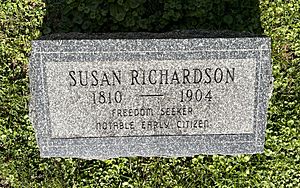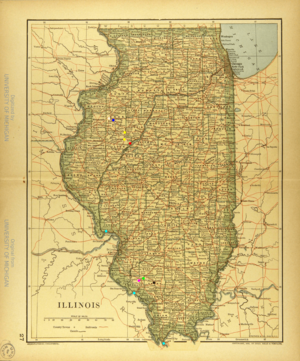Susan Richardson (Underground Railroad) facts for kids
Quick facts for kids
Susan Richardson
|
|
|---|---|

Susan Richardson's gravestone in Hope Cemetery, Galesburg
|
|
| Born | June 6, 1810 |
| Died | June 16, 1904 (aged 94) |
| Resting place | Hope Cemetery, Galesburg, Illinois |
| Other names |
|
| Known for | Escaping enslavement in Illinois via the Underground Railroad, helping to found Allen Church AME in Galesburg |
| Relatives | Susan E. Cannon Allen (great-granddaughter) |
Susan Richardson (June 6, 1810 – June 16, 1904) was a brave woman who escaped from slavery. She was also known as Aunt Susan and Susan Van Allen. After gaining her freedom, she helped start Allen Chapel AME Church in Galesburg. This town was a very important safe place on the Underground Railroad, a secret network that helped enslaved people find freedom.
Susan Richardson's escape led to a big court case in 1844 called Borders v. Hayes. While living in Galesburg, she continued to help other enslaved people escape to freedom using the Underground Railroad.
Contents
Susan Richardson's Early Life
Susan Neil was born on June 6, 1810, in Virginia. She was forced into slavery by Andrew Borders. He received her as part of a dowry when he married Martha Borders. In 1816, the Borders family moved from Georgia to Illinois, bringing Susan and three other enslaved people with them.
Even though Illinois was considered a "free" territory, it had laws about indentured servants. These laws often allowed people to be held in slavery. On January 10, 1817, when Susan was just five years old, she was officially registered as an indentured servant to Andrew Borders.
When Susan escaped, she was about 31 years old. She took her three young sons with her: Jarrot, who was about 12, Anderson, almost 4, and Harrison, about 2. Some reports say her oldest child was 17. It is believed that Jarrot was Andrew Borders' son. Susan decided to run away because Borders threatened her children. She escaped with Hannah, a 19 or 20-year-old woman who was also enslaved by Borders.
The Fight for Freedom in Court
A court case called Friends of Rational Liberty vs. Borders happened in April 1842. This case was about whether slavery was legal in Illinois. It started after Andrew Borders badly hurt Sarah Morrison, another enslaved woman he held. Sarah escaped and later fled to avoid being found. She left her daughter Hannah with Susan Richardson.
Borders sued a neighbor for helping Sarah. He won at first, but the decision was changed later. People who supported freedom formed a group called the "Friends of Rational Liberty." They sued Borders for hurting Sarah. This case also questioned if slavery could legally exist in Illinois. Borders won this case too, arguing that slavery had always been allowed in the area.
The Friends of Rational Liberty appealed the case to the Illinois Supreme Court. They wanted the court to decide if holding people in slavery was legal. The Supreme Court said they could not make political decisions. They believed the people should decide on the rights of Black individuals. However, all of Borders' enslaved people, including Susan Richardson, had already escaped before the final decision was made.
Susan Richardson's Escape to Freedom

Susan Richardson escaped from Andrew Borders on September 15, 1842. She left with her three children and Hannah Morrison. The exact dates of their escape are a bit unclear. One book says they escaped on August 31, 1842.
They likely used the Underground Railroad, traveling from Cairo to Canton and then to Farmington by September 5. During this journey, they arrived at William Hayes’ farm near Eden. Hayes supposedly helped Susan and her children on their way to Knoxville. People in Knoxville later said Hayes helped them. Some said he went with Susan on a boat, and others said part of their trip was in his wagon.
In Knoxville, Susan, her sons, and Hannah Morrison were arrested. They were held in the Knox County Jail for six weeks. Then, they were put up for auction, supposedly to pay their jail fees. Many people came to watch, but only one bid was made for Hannah, for fifty cents.
After the auction, Susan and her children were released. Susan rented a home in Knoxville and worked as a housekeeper. Her two younger boys helped her clean, and Jarrot, her oldest son, worked on a nearby farm.
In late 1843, Andrew Borders came to Knox County with papers claiming Susan and her children were his indentured servants. He showed these papers to the sheriff and went to get the boys from their hotel. Borders found the younger children in the hallway. Sadly, the oldest son was also captured. Borders said he could not get to Susan because she "either ran away or was taken away."
After capturing the boys, Borders took them to the Knox County Jail. He paid their jail fee and took them away. Borders believed that if he captured the children, Susan would follow them. Susan was heartbroken and wanted to go after her children. However, her friends convinced her to escape instead. It is thought that Charles Gilbert helped Susan, dressed in Mrs. Cole’s clothes, travel to Galesburg.
After these events, people in the community sued Borders. They believed his actions were wrong and that his indentured servant papers might not be real.
Legal Battles for the Children
A group called the Indentured Servant Committee sued Borders. They thought his papers were fake or had problems. They also sued Borders in Susan Richardson’s name for wrongly holding her boys. Borders was asked to show the papers for the boys but refused. He then left town.
A warrant was issued for Borders and his son. They were arrested and found responsible for wrongly holding the children. They were fined. Borders finally showed the papers, but the committee found them faulty because Jarrot’s age was cut out. Borders and his son were fined again, but they refused to pay. For this, they were sent to the same jail where Susan’s children had been held.
The jail was described as cold and uncomfortable. However, Borders and his son did not stay long because someone paid their bail. The children, though, disappeared. It is believed that Borders and the sheriff were involved in their disappearance. It is thought the boys were taken south and sold. In 1844, it was reported that Jarrot died in a mill accident.
Borders vs. Hayes Court Cases
On February 8, 1843, Andrew Borders sued William Hayes. Borders asked for money because he said Hayes helped Susan Richardson, Hannah Morrison, and Susan's three children escape. The case was moved to Pinckneyville, Illinois. Hayes felt that people in Randolph County were against him because he helped the Underground Railroad. The trial started on April 18, 1844.
Borders argued that Susan Richardson and her children were his property. He said William Hayes broke the law by helping them escape. Borders listed seven reasons against Hayes:
- Helping his servants escape from September 15 to December 1, 1842.
- Helping Sukey (Susan Richardson) escape.
- Helping another servant escape.
- Tricking away three of his apprentices.
- Tricking away Jarrot.
- Tricking away Anderson.
- Tricking away Harrison.
Hayes said the case was not legal. He lost, and Borders was awarded $300. This money was meant to cover the costs of finding Hannah, Susan, and her children. Hayes then asked for a new trial. He said the decision was wrong and that improper evidence was used. The court refused his request.
So, Hayes appealed the case to the Illinois Supreme Court. His lawyers argued that some parts of the case were mixed up. They also said the way Richardson's children were given to Borders was wrong and not valid. They argued that the slave registry was not properly certified. Borders’ lawyers argued that everything was done correctly. The Supreme Court agreed with Borders and upheld the earlier decision.
Freedom and Later Life
After arriving in Galesburg, Susan Richardson moved into a house. She became known as “Aunt Susan,” “Aunt Sukey,” and “Mrs. Richardson.” In 1846, she married Harry Van Allen. They had three children: Evelene, Mary, and Owen. Around 1857, Susan married Thomas Richardson. Thomas had come to Galesburg with his eight children, also escaping slavery through the Underground Railroad.
Susan Richardson became a "conductor" on the Underground Railroad in Galesburg. This meant she helped other enslaved people, like Bill Casey, escape to freedom.
Allen Chapel AME Church
In 1851, Susan Richardson started hosting prayer meetings at her home. These meetings were for the growing Black community in Galesburg. By 1853, these gatherings became a church led by Rev. J. W. Early. In 1855, Susan learned about an A. M. E. meeting in Chicago. She sold her only hog and its babies to pay for her trip there.
In 1858, Rev. Woodfork came to Galesburg to help the church move from Susan's house to its own building. By 1860, the A. M. E. Allen Church was built. Susan's husband, Thomas Richardson, was one of the first leaders of the new church.
Susan Richardson passed away from old age on June 16, 1904. She died in Chicago at the home of her daughter, Mary Fleming. She was buried in Hope Cemetery in Galesburg. One of her great-granddaughters was Susan E. Cannon Allen, who worked for women's voting rights and temperance.
Images for kids


